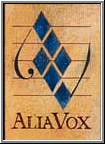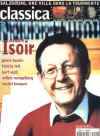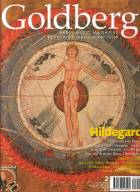|
Henry Purcell
(1659-1695)
The Fairy Queen &
The Prophetess |
|
/aliavox_heritage.jpg) |
|
Réédition / Reissued
Alia Vox AVSA9866
Code-barres/Barcode :
7619986398662 |
|
Édition remasterisée |
Remastered edition |
|
Super Audio CD |
|
|

Collection Héritage vol. 4
|
Description
Artistes / Performers
Le Concert des Nations
Direction: Jordi Savall
Lieu d'enregistrement / Recording site:
Collégiale romane du Chateau de Cardona, Catalogne (Catalunya)
Date d'enregistrement:septembre 1996
Recording date: September 1996 Durée totale / Total time: 62'53"
 |
 |
Édition
originale/Original recording
Astrée - 8583 |
Réédition /
Re-issued Naïve -
9934 |
|
|
|
 |
|
"Le Savallisme rayonnant de la gravure
-raffinement sonore et expressivité fluide et mordante- met
en lumière le génie de l'Orphée Britannique. Le compositeur
baroque ne pouvait espérer meilleure illustration de son
génie"
Camille de Joyeuse
(ClasiqueNews.com). |
"Another glorious production by Savall - beautiful sound and
fluid expressiveness - highlighting the genius of the
British Orpheus. The Baroque composer couldn't be better
served by this CD"
Camille de
Joyeuse (ClasiqueNews.com).
|
|
Évaluations recensées / Reviews
located |
|

08/1997
+ 01/2010
See below |

#
440 (09-1997)
Voir ci-dessous |

#
20 (03/2000)
Voir ci-dessous |
|

Vol.
21: 3 (01/02-98)
Vol. 33: 3 (01/02-10)
See below |

# 2 - (Hiver/Winter 1998)
Voir ci-dessous
|

Full text / texte intégral
Review by:
Victor Carr |

Reviewer:
Nicholas Anderson
   

(08/2009) |

Reviewer: John Sunier
    |

Par: Camille de Joyeuse |

Par: Frédéric Gabriel |
|

Henry Purcell
The Fairy Queen |

Henry Purcell
The Fairy Queen |
|

Extrait du livret / From the liner notes |
|
 Henry Purcell (1659-1695)
Henry Purcell (1659-1695)
The Fairy Queen and the ProphetessLes Anglais vinrent
tardivement à l’Opéra. À la suite de la restauration de la
monarchie en 1660, on aurait pu s’attendre à un engouement
général pour ce genre nouveau. Car l’étranger revenait à la
mode ; le roi Charles II lui-même donna la réplique aux
Vingt-Quatre Violons du Roi de Louis XIV en créant sa propre
formation, tandis qu’en France, l’opéra italien prit un
nouvel essor dans sa terre adoptive. Mais en Angleterre, les
premières tentatives de transplantation de l’opéra, en
italien ou en anglais, échouèrent sans qu’i1 y ait pour cela
de raisons évidentes. En revanche, la pratique locale
d’insérer des intermèdes musicaux dans des pièces de théâtre
ou dans des masques, s’imposait plus fortement. Ces pièces
pouvaient servir soit d’introduction (Ouvertures), soit de
commentaire (airs, chœurs et autres pièces vocales), ou
encore d’accompagnement aux chorégraphies ; mais le plus
souvent, leur rapport avec l’action scénique était minime. A
mi-chemin entre cette sorte d’intermède et l’opéra
proprement dit, il y avait le « semi-opéra », type indigène
né plus vraisemblablement d’une forte méfiance envers
l‘opéra que de considérations financières : la dépense
relative d’une représentation scénique de The Fairy Queen
étant sans doute comparable à celle d’un opéra continental.
Poursuivez votre lecture - texte intégral
AVSA 9866 : Cliquez ici
~~~~~
 Henry Purcell (1659-1695)
Henry Purcell (1659-1695)
The Fairy Queen and the Prophetess
The English were
latecomers to the opera. Following the Restoration of the
monarchy in 1660, one might have expected the theatrical
establishment to embrace the new genre enthusiastically:
after all, things foreign were once again in fashion.
Charles II himself established a troupe of string players in
frank imitation of Louis XIV’s Vingt-Quatre Violons du Roi,
while in France itself, Italian opera, having been
successfully transplanted, soon thrived in its new soil. But
for some reason, the first attempts at popularizing opera in
England (whether in Italian or in the vernacular) were
failures. Instead, the practice of introducing incidental
music within plays and masques assumed increasing
importance. Such music could either set the action (in the
manner of an Overture), comment upon it (in the case of
vocal numbers), or else accompany danced items; but in any
case its relationship to the plot was often peripheral.
Midway between this simpler kind of incidental music and the
full-blown opera stands the semi-opera, an indigenous genre
borne largely out of fashionable aversion to opera itself:
after all, the expense of a fully-staged production of The
Fairy Queen would have been at least comparable to operatic
extravaganzas on the continent.
Read on - Full text
AVSA 9866:
Click here
|
|
Gramophone-
(08/1997)
|
GRAMOPHONE
ARCHIVE
-
Texte intégral anglais
- Full text |
Subscription
Abonnement
|
|
Reviewer:
Jonathan Freeman-Attwood
Excerpts-:
"The
seven short movements from Dioclesian are nobly conceived, the
"Dance of the Furies" typical of Savall's
long-breathed lines and dark, bass-heavy string palette. Whether
such a purposeful and imposing dramatic profile distorts the sweet
airiness of Purcell's
vernacular is more a matter of taste than anything. Savall is never
less than colourful and there is much to be said for his admirable
musical instinct, which brings moments of glorious shapeliness and
elasticity in the substantial Fairy Queen suite."
"The
playing from Le Concert des Nations is affectionate, though pretty
rough-hewn in places."
Read on |
Gramophone-
(01/2010)
|
 |
GRAMOPHONE
ARCHIVE
|
Subscription
Abonnement
|
Reviewer:
David Vickers
Excerpts-:
"The disc has aged well, notwithstanding
such occasional eccentricities. During the Dioclesian suite, Le
Concert des Nations plays the Dance of the Furies with plenty of
muscular verve (JFA called it "dark" and "bass-heavy",
and this assessment remains spot on 13 years later), and the trumpet
tunes are direct yet charismatic. Music from each of
"The Fairy Queen"s
five acts is judiciously organised into suites, and the
instrumental playing aptly conveys soft
sensuousness (eg the Rondeau from Act 1), lyrical expressiveness (the
ritornello of "If Love's a Sweet Passion"
from Act 3, beguilingly played by concertmaster Manfredo Kraemer),
scampering playfulness (the Prelude in Act 5) and bold splendour (the
Act 4 Symphony). Those who missed this disc first time around might
find great pleasure in Savall's
imaginative shaping of Purcell's musical
moods."
|
|
Diapason- # 440
(Sept.
1997)
|
|
Appréciation
4 Diapasons
Evaluation
|
Abonnement
Subscription |
|
Analyste: Ivan
A. Alexandre
Résumé ou abrégé:
"... De
la longue ouverture au Bird's Prelude, de la Danses
des fées à la Symphonie des cygnes, un monde
fantastique et nocturne s'anime en vingt-six numéros... Nocturne est
d'ailleurs la lueur où Jordi Savall plonge cette mosaïque. Rêveuse
fées de l'acte III, qu'on imagine dépêchées par Marin Marais;
mélancolique Bird's Prelude visité par Couperin -
contrebasse, flûtes traversières et notes inégales tournent le
disque entier vers la France de 1710... Un seul danger guette
l'auditeur; non le décousu, au contraire: l'homogène. Les Hommes
verts (acte III), sauvages enshakespearés (sic), ont la mine
bien sociable, tandis qu'on a gommé tout dehors rustique aux
Faneurs qui les suivent. Même retenue dans les pages éclatantes
de l'Acte IV,.... Le phrasé des cordes, la chaleur des bois, le luxe
des voix intermédiaires, rien ne nous manque. Non plus que dans les
six fragments de Dioclesian, premier dramatick opera
de Purcell avant King Arthur et The Fairy
Queen, et dont Savall fait pertinemment son prologue"...
|
|
Classica- # 20
(03/2000)
|
 |
Appréciation
Note : 5
Evaluation
|
Abonnement
Subscription |
Analyste: Stéphan Perreau
"Justement, de cette musique vocale de Purcell,
Savall nous donnait pour sa dernière collaboration avec Astrée deux
suites de danses raffinées. Concurrent direct de Roy Goodman, il en
tire ici le meilleur parti.'
|
|

# 2
(Hiver/Winter 1998)
|
 |
Appréciation
 
Evaluation
|
Goldberg a cessé de publier
avec le # 54
~~~~~~
Goldberg is no longer available.
# 54 was the last issue. |
Reviewer: Brian
Robins
Excerpt:
"Were I writing this review solely for
domestic readership, my inclination would be to dismiss these
performances out of hand, for by English standards this is not
idiomatic Purcell."
"I don't think this can be accounted as one of Savall's more
successful disc. His Purcell is soft-grained, with tempos that are
often slower than normal ant the line is almost invariably
emphasized at the expense of rythm. Time and again, one is aware of
how French the musics sounds, the composer's natural open English
breeziness sanitised into the artificial world of fêtes
galantes."
"The present disc is only recommended to those who prefer the
notion of Monsieur Purcell to Mr Purcell". |
|
|

Vol. 21: 3 (01/02-98)
|
 |
Subscription
Abonnement |
Reviewer: Michael
Ullman
Abridged version :
"What Jordi Savall has done here, a
cynic might say, is find a way of playing music from Purcell's
famed semi-operas without having to deal with those pesky singers...
"... I find Jordi Savall's recording of the orchestral music from
those works absolutely delightful, stylish, energetic, and tasteful.
It is also exquisitely recorded: listen to the little Symphony that
opens the Fourth Act Suite, and you hear well-balanced strings and
brass, drumbeats that are so clear they seem to have a beginning,
middle, and end, and one hears these sounds in phrases that capture
all of the buoyant charm of Pucell's music without inflating those
sounds for audiophile effects. The recorded sound has depth as well
as presence, a realistic sounstage and full bass".
"... the music The Prophetess is less well known than all but
the more obscure numbers of The Fairy Queen. It includes a
dignified "Symphony for the Trumpets and Violins" and some
unexpected serene music introducing the "Dance of the Furies", who
are agitated if not precisely scary -- their rough edges are
suggested by jaggedly played ascending and descending phrases
rendered by the violins. Even readers well versed in Purcell's
masterpieces will want to hear this disc."
|
|

Vol. 33: 3 (01/02-10)
|
 |
Subscription
Abonnement |
Reviewer: Barry
Brenesal
Excerpts:
"Fans
of Savall know that his conducting reflects similar values to his
viola da gamba solos: a nuanced view of phrasing, exceptional
attention to the beauty and clarity of textures, and a knowledge of
appropriate embellishments."
"... I find Savall’s phrasing, along with a slightly lower
pitch and predominance of darker string instruments, mines the
natural melancholy of Purcell’s piece to greater advantage without
danger of anachronism."
"... Savall and Le Concert des Nations remain in the top tier
of performances for me. If you haven’t heard them before in this
music, by all means give them a try." |
|
| |
|
La musique / The Music |
|
The
Prophetess (1690) |
|
1. First Musick |
|
2. Second Musick |
|
3. Symphony for Trumpets & violins |
|
4. Retornella |
|
5. Dance of the Furies:
Soft music - Dance |
|
6. The Chair Dance |
|
7. Retornella |
|
The Fairy Queen
(1692) |
|
The
First Act Suite |
22. Dance for the Fairies
(22) |
|
8. First
music: Prelude (1) |
23. Dance
for the Green men (23) |
|
9. First
music: Hornpipe (2) |
24. Dance
for the Haymakers (27) |
|
10. Second
music: Air (3) |
25. Third
Act Tune: hornpipe (29) |
|
11 Second music: Rondeau
(4) |
The
Fourth Act Suite |
|
12.
Overture (5) |
26.
Symphony: Prelude, Canzona, Largo, Allegro, Adagio, Allegro (30) |
|
13. First
Act Tune: Jig (8) |
27. Entry
of Phoebus (33) |
|
The
Second Act Suite |
28. Fourth
Act Tune: Air (40) |
|
14. A
Prelude (9) |
The
Fifth Act Suite |
|
15. A "Bird's Prelude" (10) |
29. Prelude
(41) |
|
16. Echo
(12) |
30. Entry
Dance (44) |
|
17. A
Fairies Dances (13) |
31.
Symphony (45) |
|
18. A Dance
for the Followers of Night (18) |
32.
Monkey's Dance (49) |
|
19. Second
Act Tune: Air (19) |
33.
Chaconne, Dance for the Chinese Man and Woman (57) |
|
The
Third Act Suite |
34. "Fifth
Act Tune" (59) |
|
20. Prelude
"Love's a Sweet Passion" (20) |
|
|
21.
Overture: symphony while the swams come forward (21) |
|
|
Autres références disponibles via la base de
données de Todd McComb/ Other available references via
Todd McComb's database:
(Site: http://www.medieval.org)
Re:
Astrée 9934
Autres liens à
visiter / Links of interest
www.BaroqueMusic.org
A
short biography |
|
|
|
|
To order / Commander
Réédition / Reissued
Alia Vox AVSA9866
Code-barres/Barcode :
7619986398662
|
Sélectionnez votre
pays et votre devise en accédant
à Presto Classical
(Bouton en haut à droite)
Livraison mondiale |

|
Choose your country
and curency when reaching
Presto Classical
(Upper right corner)
Worldwide delivery |
|



 |
 |
|
La viole de
gambe
Parutions
récentes |
Viola da gamba
Recent
releases |













